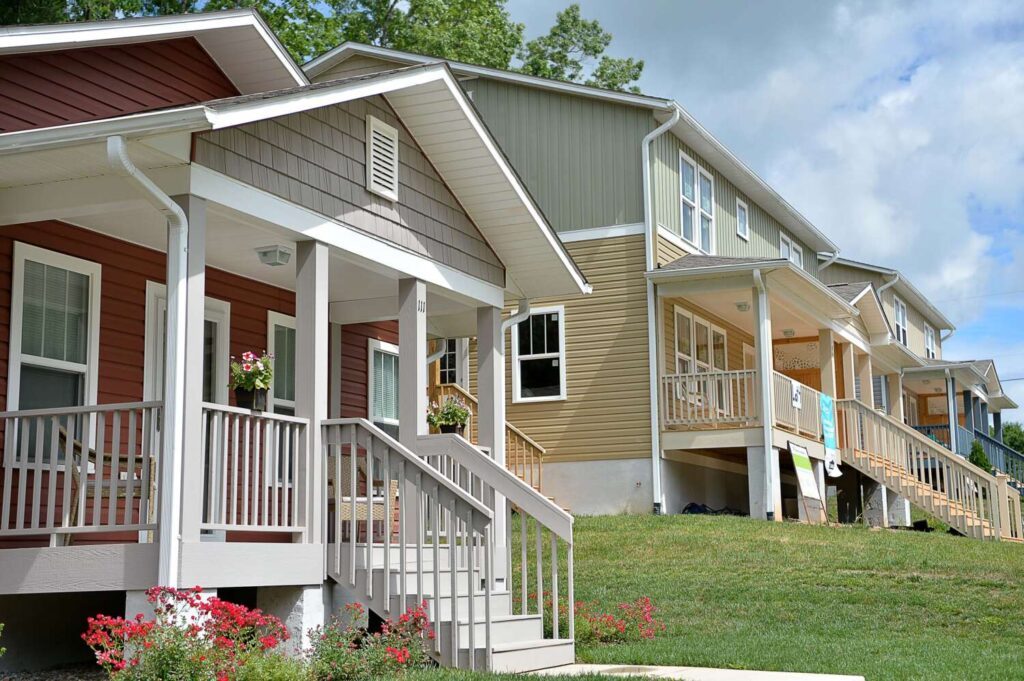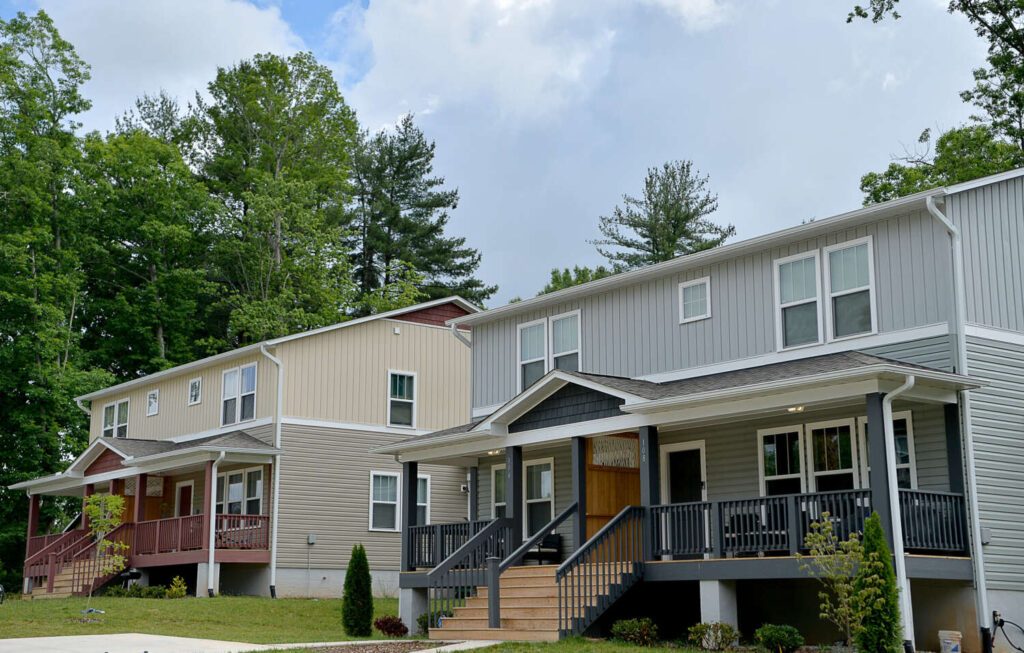On 2.7 acres in Candler, not far from shopping and services, is a thriving community of 12 certified Green Built Homes created by Asheville Area Habitat for Humanity.
Previously the site of five abandoned mobile homes, the parcel presented Asheville Habitat with an opportunity to build something other than its time-tested detached single-family arts-and-crafts-style homes. Dubbed Curry Court, the Candler community would be a small-scale test of a new housing product for Asheville Habitat: two-story townhomes.

Townhomes enabled the nonprofit builder to serve 33 percent more families on the same parcel — an important consideration due to the rising cost and limited availability of buildable land, coupled with a growing need for affordable housing. Additionally, not everyone wants a single-family detached home and maximizing land use is an environmentally smart strategy.
At Curry Court and throughout Buncombe County, Asheville Habitat defies the misconception that green building is expensive and only accessible to the wealthy. In fact, Asheville Habitat has certified more Green Built Homes than any other builder in the state — 173 since 2008.
Affordable to buy and maintain
Through Habitat’s affordable homeownership program, qualified families who earn 70 percent or less of area median income partner with Habitat to build and buy a certified Green Built Home. Future homebuyers participate in the building of their own home and the homes of their neighbors, take homeownership preparation classes, then purchase their home from Habitat and pay back an affordable mortgage over 30 years. The typical monthly mortgage payment for a three-bedroom, one-and-a-half-bath Habitat house is $650.
In addition to being affordable to purchase, it’s essential that Habitat homes are affordable to maintain. Advanced Energy predetermines the heating and cooling cost of the home using energy modeling and proper HVAC sizing. If the homebuyer properly maintains their HVAC system and thermostat setpoints and the costs exceed the predetermined amount (typically $35 to 45 per month) during the first two years of ownership, Advanced Energy will pay for the additional fees and evaluate the cause of the energy surplus. For the new homeowner, that provides peace of mind as well as incentive to take good care of the systems.
To that end, Habitat works hard to ensure homebuyers understand the importance of changing out their return-air and heat-recovery-ventilator filters every three to six months, for example. An in-depth class about home-system maintenance is part of Habitat’s Homeownership Education curriculum, and a short refresher is provided during the final walk-through on closing day.
A participant in the SystemVision program, Asheville Habitat homes include passive radon mitigation, a HRV unit, sealed crawl space, and much more.
“We keep close tabs on the crawlspace from the onset, continually monitoring the moisture levels throughout construction of the home and fully encapsulating the space as soon as it is feasible to do so,” Construction Administrator Sumaya El-Attar said.
The houses also boast high-efficiency vinyl windows, high-efficiency heat pumps and water heaters, ENERGY STAR® appliances, R-18 spray foam insulation, R-15 wall insulation, and R-19 floor insulation. Habitat is proud of how tight their homes are, and homeowners are appreciative.
“The money I will be saving from having affordable heating, I can put into my savings account,” said new Curry Court townhome owner Belinda Finley, who was paying nearly $400 per month in heating costs during the winter as a renter. “That’s going to mean a lot to me.”
Trying something new
Asheville Habitat works with Vandemusser Design, a third-party Home Energy Rating System (HERS) rater that gathers efficiency information through a frame-and-insulation inspection and blower-door test and ensures SystemVision compliance. The Green Built Homes certification is presented by Green Built Alliance, the program administrator.

While townhomes were a welcome addition, the new model required new equipment and extensive training. Habitat staff had to learn new processes and teach hundreds of volunteers the new ropes — or in this case, the new scaffolding. The townhomes are two stories, a departure from Habitat’s single-story detached homes. A new scaffolding system that encompasses the entire structure was purchased to ensure staff and volunteers could work safely at heights.
“Our volunteers are excited by new things, they love to be challenged,” El-Attar said.
Eager to learn and be involved, they showed up in droves to a safety training that was required for staff, but optional for volunteers.
Also new to Habitat’s construction crews were firewalls. Wide and heavy, it took a minute for the staff to determine the best way to install the thick wall between two townhome units. Interior stairwells with half-walls upstairs and finishing caps were new too. The townhome layout and design also necessitated new types of lighting, such as wall sconces in the stairwell and pendant lights above the kitchen island. And the upstairs bedrooms include hypoallergenic and antimicrobial berber carpet.
It proved highly successful to use the small Curry Court community as an opportunity to learn the best way to build the new housing model. In Habitat’s largest community to date, the 98-home New Heights neighborhood under construction off Old Haywood Road in West Asheville will include more two-story townhomes, the time-tested single-family homes, and a brand new housing type with single-level Aging in Place townhomes for adults age 55 and older.
A well-oiled machine
Green building has immediate and long-lasting positive impacts above and beyond the commonly cited environmental ones. In Habitat’s case, there are financial benefits for both the nonprofit and the homebuyer. A low HERS score means Habitat receives a rebate from Duke Energy of about $2,500 per house, while a Green Built Homes certification generates a $6,000-per-house grant from the North Carolina Housing Finance Agency, both of which make homes even more affordable to the homebuyer.
A low monthly mortgage is only part of what makes a Habitat home affordable. Low maintenance costs contribute significantly to the long-term affordability of a home, so Habitat works hard on the front end to build energy-efficient homes and educate homebuyers on how to properly maintain them.
“The goal is to build a home that runs like a well-oiled machine,” said El-Attar.
Ariane Kjellquist is the communications director for Asheville Area Habitat for Humanity. She has worked since 2006 for the local nonprofit, which builds and repairs homes, operates two ReStores, and offers deconstruction services. Connect with Ariane at ashevillehabitat.org.
You can also view this article as it was originally published on pages 16-17 of the 2020-2021 edition of the directory.

